8 Types of Hawks in Kentucky (With Pictures)
Kentucky, a state known for its rich biodiversity, is home to an array of raptors, including 8 unique species of hawks. These magnificent birds of prey, comprising the Red-tailed Hawk, Cooper’s Hawk, Sharp-shinned Hawk, Red-shouldered Hawk, Broad-winged Hawk, Northern Harrier, Rough-legged Hawk, and the elusive Northern Goshawk, add a touch of grandeur to Kentucky’s skies.
Hawks, as top predators, play an instrumental role in maintaining the health of the ecosystem. They are fundamental to controlling the populations of small mammals and birds, contributing significantly to the ecological balance. Their presence or absence can offer invaluable insights into the health of the environment, making them critical indicators of ecological well-being.
Studies published in ornithological journals such as ‘The Auk’ and ‘The Condor’ have emphasized the diversity and ecological importance of hawks in the region. In Kentucky, these hawks range from the more commonly spotted Red-tailed Hawk to the rarely seen Northern Goshawk, each species offering unique characteristics and behaviors.
The upcoming sections offer a comprehensive overview of each hawk species found in Kentucky, highlighting their distinguishing features, behaviors, migration patterns, the challenges they face, and the efforts towards their conservation.
Which are the 8 Species of Hawks Found in Kentucky?
Kentucky hosts a diverse range of hawks, each with its distinctive traits. From the ubiquitous Red-tailed Hawk to the elusive Northern Goshawk, these raptors adorn Kentucky’s skies. Understanding each species forms the cornerstone of our exploration.
Table 1: Hawk Species in Kentucky
| Hawk Species | Description |
|---|---|
| Red-tailed Hawk | Known for its reddish-brown tail, it’s the most common hawk species in Kentucky. |
| Cooper’s Hawk | Medium-sized raptors with a long tail and rounded wings, they’re adept at navigating dense forests. |
| Sharp-shinned Hawk | The smallest hawk in Kentucky, they’re swift fliers often found hunting in woodlands. |
| Red-shouldered Hawk | These hawks bear a reddish-brown shoulder patch and are found in forests near water bodies. |
| Broad-winged Hawk | Identified by their broad wings, they’re migratory raptors usually found in Kentucky during summer. |
| Northern Harrier | Unique among Kentucky hawks with an owl-like facial disk, they’re often spotted flying low over open fields. |
| Rough-legged Hawk | Named for their feather-covered legs, they’re visitors from the Arctic seen during the winter months. |
| Northern Goshawk | The largest of the Accipiter genus, these elusive hawks prefer mature forests. |
With this broad overview, we can now dive deeper into the fascinating details of each species.
1. Red-Tailed Hawk (Buteo Jamaicensis)
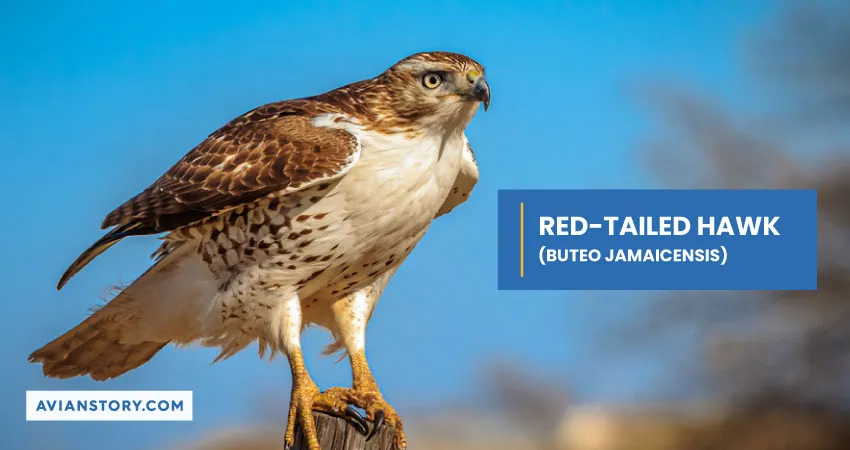
The Red-Tailed Hawks are the most common among all the types of hawks in North America. If you live in Kentucky, there is a high chance that you have seen one. They fly the skies of Kentucky all year round.
One of the things that make Red-Tailed hawks stand out is their wings. They are large and rounded, making you think of a goose. And just like the name suggests, these birds have distinctive red tails.
Although the wings are pretty large, the tail is more on the short and wide sides. These birds also have pale underneath with a streaked belly and brown back.
They are also known for their iconic raptor screech. This screech is easily recognizable as most television shows and movies use the same sound to portray hawks.
Red-Tailed hawks have a specialized diet. They mostly prefer mice, voles, and mammals. However, they will not attack cats and dogs. They mostly prefer small mammals, such as raccoons, ground squirrels, moles, and rabbits.
These hawks prefer to nest on the highest points. That includes the top of the buildings, the tallest trees, and cliff ledges. Female Red-Tailed hawks lay anywhere from 1 to 4 eggs, which are usually whitish or brown-spotted.
2. Red-Shouldered Hawk (Buteo lineatus)
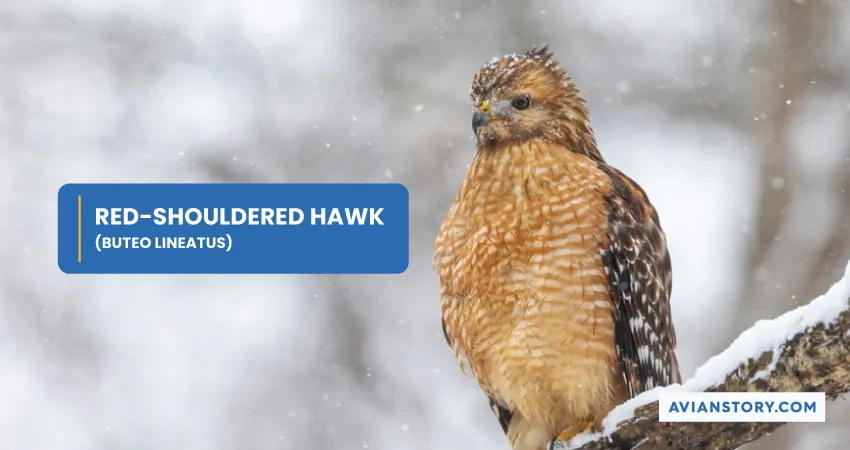
The Red-Shouldered hawks are seen throughout the year in Kentucky. You will often find them around the creeks and streams. And during the spring, these birds tend to circle around the nesting area.
As the name suggests, Red-Shouldered hawks have reddish wings. The rest of the body is decorated with eye-catching black and white feathers. They also feature a pale underside, and their tails have white banding.
There are translucent crescents around their wingtips, one of the special features that helps bird watchers spot Red-Shouldered hawks.
Red-Shouldered hawks are not picky regarding their diet. However, they typically live off rabbits, reptiles, amphibians, rodents, and other small mammals.
The Red-Shouldered hawks tend to be around wet areas. They will often be seen flying pretty close to the ground. But when it comes to nests, they prefer tree crotches.
Female Red-Shouldered birds can lay anywhere from 3 to 4 eggs. The eggs are generally bluish to white in color.
3. Cooper’s Hawk (Accipiter Cooperii)
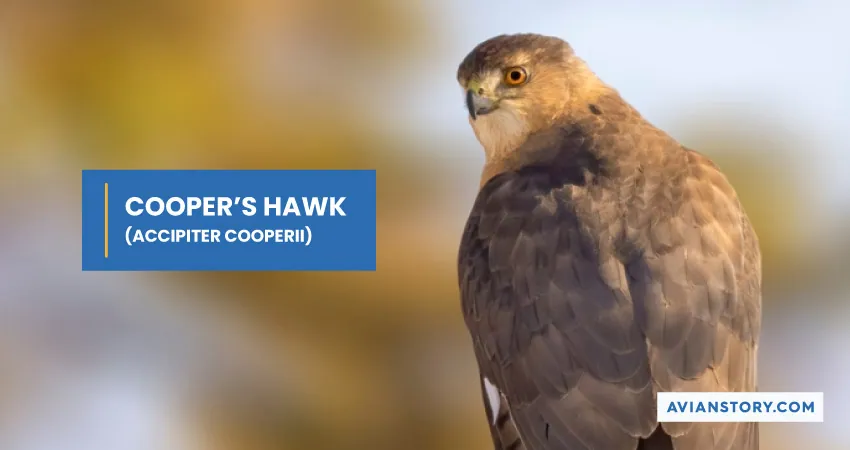
Like the other two birds described above, you will see Copper’s hawk all year round in Kentucky. They will most often be seen on the edge of the forests. These birds avoid populated areas. However, you can sometimes see them in backyards.
Copper’s hawks have a very similar outlook to sharp-shinned hawks. That is one of the reasons why it is difficult to differentiate one from the other. However, Copper’s hawk still has some special traits.
In comparison, Copper’s hawks are large in size. They also have broader wings. These birds have camouflaged feathers, which help them to blend well in the tree branches.
These birds mostly feed on quails, woodpeckers, chickens, plump fowl, and other smaller mammals. They are watchful birds and can spend hours in the canopies waiting for the right prey.
Cooper’s hawk nests in oaks, beeches, Douglas-firs, spruces, beeches, and other types of trees. Their nests are 10 to 60 feet high.
Females can lay anywhere from 3 to 5 eggs. The eggs of Cooper’s hawks are bluish-white or blue.
4. Northern Harrier (Circus cyaneus)
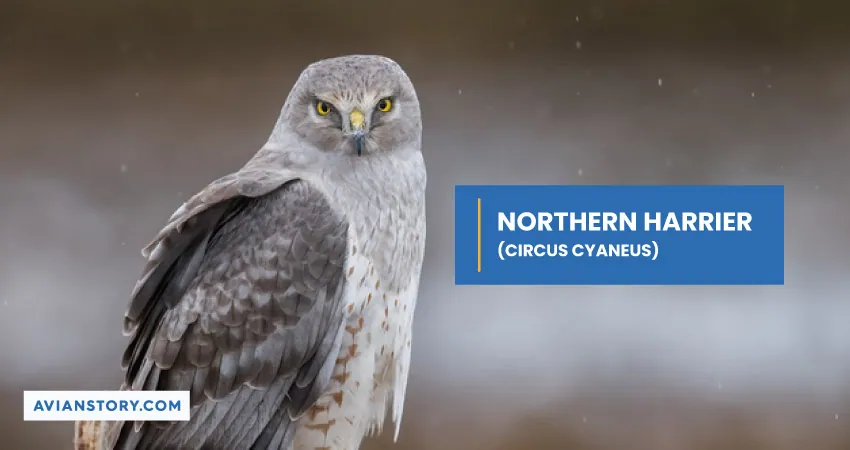
The Northern Harrier hawks are generally found in marshes, prairies, and open fields. In Kentucky, they are mostly seen during the spring.
Northern Harriers have broad wings and rounded tails. Many bird watchers can confuse them with owls as they look pretty similar to those birds. Other than that, they have medium and slender bodies.
These hawks like to feed on small mammals and small birds. However, they can carry large prey, such as rabbits, if they want to. You should also know that their diets change depending on the seasons.
Among all the hawk species found in Kentucky, the Northern Harriers are the only ones that nest on the grounds.
You can spot their nests in prairies, marshes, and open fields during spring. However, they tend to conceal the nests pretty well, making it hard for you to spot one.
Female Northern Harriers lay 4 to 9 eggs during the mating season. These eggs can be faded-white, pale bluish-white, and spotted.
5. Broad-Winged Hawk (Buteo platypterus)
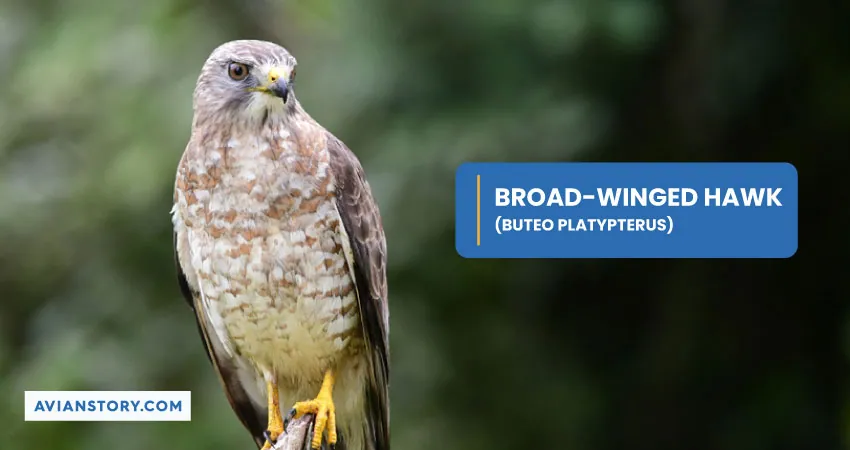
You will not see Broad-Winged hawks all the time in Kentucky. Generally, they can be seen flying in the sky around April and August. Those two months are their breeding season.
However, if you are lucky enough, you can spot them during the fall, which is the season when they migrate.
One of the unique things about Broad-Winged hawks is that they are small in size. They have stocky bodies and relatively large heads. The heads of these hawks are reddish in color.
When it comes to the barring, they are pretty similar to Red-shouldered hawks. However, instead of red coloration, the barring is rather brown.
Another standout feature of the Broad-Winged hawks is their piercing whistle. It is single-pitched, which they only make during hunting.
The adults often prey on eagles, other hawks, and, surprisingly, the great horned owls. Other than that, the diet of the Broad-Winged hawks includes lizards, frogs, snakes, young turtles, and other small mammals.
The Broad-Winged hawks will usually nest in the first main crotch of a tree. They tend to choose a deciduous tree for nesting. Besides that, they can nest on horizontal branches of trees.
Females will generally lay 1 to 5 eggs. The eggs of Broad-Winged hawks are typically whitish and have brown spots on them.
6. Sharp-Shinned Hawk (Accipiter striatus)
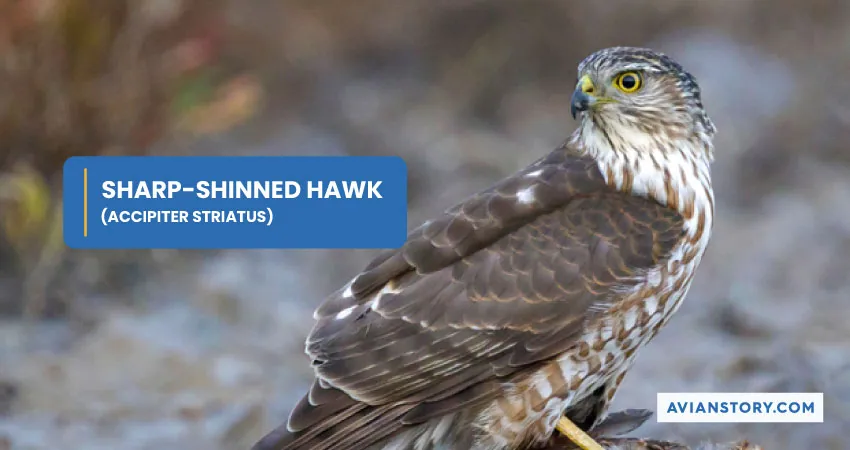
The Sharp-Shinned hawks fly through dense forests. They take advantage of the lush nature of the forests to surprise their prey. You will only find them flying high in the open sky when they are migrating.
These hawks are small, and they have short and round wings. However, they have long tails and long legs. Although they are short, they can fly through forests at a rapid speed. You can catch them flying at a soaring 60 mph speed.
Even though these birds mostly stay in the forests, they often come to populated regions. And that is where they feed on songbirds. They are known for targeting unsuspecting songbirds near bird feeders.
Apart from that, they feed on snakes, squirrels, large-sized insects, and rodents.
The Sharp-Shinned hawks tend to nest on the top of tall trees. They prefer not to choose trees that do not have dense covers.
During the breeding season, females can lay up to 5 eggs. And the eggs of Sharp-Shined hawks are blue-white in color and will have brown marks on the surface.
7. Rough-Legged Hawk (Buteo lagopus)
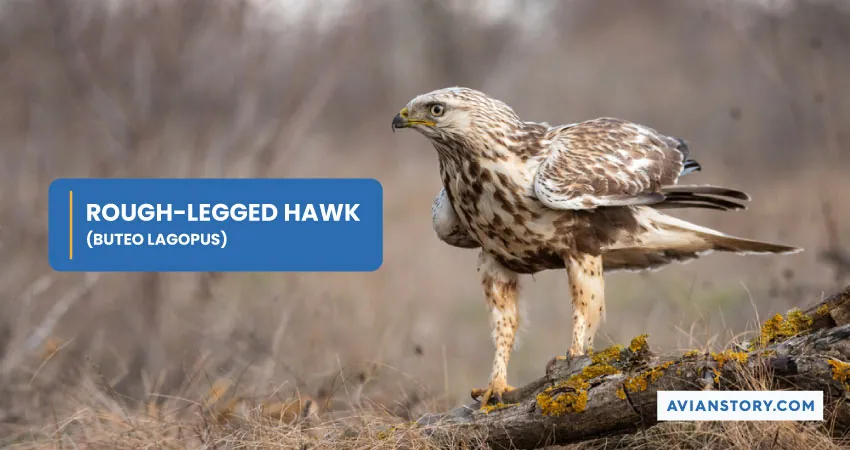
The Rough-Legged hawks have a unique flying pattern. They fly while facing the sky. Nonetheless, the ones that are typically seen in Kentucky are non-breeding.
These birds are large to medium in size. They have broad wings that are pretty thin. And most of the Rough-Legged hawks have white and dark-brown coloration. Some have dark and light morphs.
Furthermore, their legs are fully feathered, which is the exact reason why they are called “Rough-Legged.”
The Rough-Legged hawks often fly up facing the wind when they are hunting. They hover around and search for prey, such as small rodents. But in summer, they love to feast on voles and lemmings during the summer.
They nest around the outcroppings and on cliffs of low-lying boreal forests, uplands, treeless tundra, and alpine regions. Mostly, you will find the nest of these birds near cliffsides.
The females can lay between 3 to 5 eggs, which are bluish-white in color. These eggs take around 31 days to incubate.
8. Northern Goshawk (Accipiter gentilis)
The Northern Goshawk (Accipiter gentilis) is one of the larger members of the Accipiter genus, recognized for its powerful build and exceptional agility. It is a rarely seen bird in Kentucky, as it generally prefers the solitude of deep forests in the northern parts of North America and migrates only under severe winter conditions.
The Northern Goshawk is a fierce predator, known for its bold and aggressive hunting tactics. It feeds primarily on small to medium-sized mammals and birds, including squirrels, rabbits, and a variety of game birds. Occasionally, it may even take larger prey such as geese and other raptors. Its hunting prowess is facilitated by its short, rounded wings and long tail, which allow it to maneuver deftly through dense forests.
In terms of nesting preference, the Northern Goshawk often chooses mature, undisturbed forests with a high canopy and sparse undergrowth, favoring areas that offer ample hunting opportunities. The nests are usually built in large trees, often conifers, and are relatively large structures made of sticks and lined with softer materials.
The female Goshawk typically lays 2 to 4 eggs per clutch, which are bluish or whitish with brown speckles. The incubation period lasts around 28 to 38 days, during which the male brings food to the nest. The young fledge at about 5 to 6 weeks of age but may continue to rely on their parents for food for another few weeks. The Northern Goshawk exhibits a strong territorial behavior, especially during the breeding season, often vigorously defending its nest from intruders.
Table 2: Comparative Analysis of Different Hawk Species in Kentucky
| Species | Size | Wingspan | Weight |
|---|---|---|---|
| Red-tailed Hawk | 18-26 inches | 38-43 inches | 24.3-51.5 oz |
| Cooper’s Hawk | 14.6-17.7 inches | 24.4-35.4 inches | 7.8-24 oz |
| Broad-winged Hawk | 13.4-17.3 inches | 31.9-39.4 inches | 9.3-19.8 oz |
| Red-shouldered Hawk | 16.9-24 inches | 37-43.7 inches | 17.1-27.3 oz |
| Sharp-shinned Hawk | 9.4-13.4 inches | 16.9-22.1 inches | 3.1-7.7 oz |
| Northern Goshawk | 20.9-25.2 inches | 40.5-46.1 inches | 22.3-48.1 oz |
| Rough-legged Hawk | 18.5-20.5 inches | 52-54.3 inches | 25.2-49.4 oz |
| Northern Harrier | 18.1-19.7 inches | 40.2-46.5 inches | 10.6-26.5 oz |
What are the Habitats of Different Hawks in Kentucky?
The diversity of Kentucky’s landscape provides an ideal home for eight different hawk species, each favoring distinct habitats ranging from dense forests to expansive open spaces and even urban environments.
The Diverse Habitats of Red-tailed Hawks
As habitat generalists, Red-tailed Hawks are accustomed to a variety of environments. These hawks predominantly prefer open country, edge habitat, and even urban locales. Though highly versatile, they typically favor areas with high perching spots that overlook open landscapes, facilitating their hunting process. Farmlands, pastures, parks, and even roadside poles in Kentucky often serve as their ideal perches.
The Forest-Dwelling Cooper’s Hawk
Cooper’s Hawks have a strong preference for forested environments. Dense woodlands, especially mature hardwood and mixed deciduous-coniferous forests, are their favored hunting grounds. However, the growing abundance of bird feeders in suburban neighborhoods in Kentucky has also attracted these agile hunters into urban areas.
The Migratory Broad-winged Hawk
Primarily forest dwellers, Broad-winged Hawks favor large, unbroken stretches of hardwood forests for nesting and hunting. These hawks are known for their spectacular long-distance migration from North America to South America during winter, returning to their breeding grounds in Kentucky come spring.
The Wetland-Loving Red-shouldered Hawk
Red-shouldered Hawks have a fondness for wetland habitats. They are frequently found in riparian forests, swamps, and riverside habitats, where amphibians—a primary food source—are plentiful. In Kentucky, they’re often spotted near wet woodlands and marshy lowlands.
Sharp-shinned Hawks and Their Dense Woodland Habitats
Sharp-shinned Hawks, the smallest hawks in America, are secretive birds that prefer dense forests and woodlands. In Kentucky, they often reside in mature forests with thick understory, using their adept flying skills to pursue prey through the vegetation.
Northern Goshawk: The Secluded Forest Predator
The elusive Northern Goshawk is primarily a bird of mature, secluded forests. They prefer large tracts of uninterrupted woodland, providing them ample coverage for hunting. While not frequently spotted in Kentucky, they’ve been sighted in dense forest areas, particularly during winter.
Rough-legged Hawk: The Open Country Hunter
Rough-legged Hawks are visitors to Kentucky during winter, migrating from their Arctic breeding grounds. They are birds of open country, often seen soaring over fields and wetlands in search of prey. They favor areas with minimal trees, providing them a clear view of potential meals on the ground.
Northern Harrier: The Marshland Raptor
Unique among hawks, Northern Harriers primarily inhabit open marshlands and meadows. Their preferred hunting grounds in Kentucky include grasslands, fields, and marshy areas. The bird’s distinctive flight pattern, flying low over these open areas while hunting, makes them easily identifiable.
How to Spot and Identify Hawks in Kentucky?
Spotting and identifying hawks in Kentucky can be a thrilling pastime. There are key attributes to look for including size, shape, color patterns, and behavior. Hawks can often be seen soaring in the sky or perched on high points surveying the ground for prey.
Size and Shape
Size and shape can give you important clues about the identity of a hawk. For instance, Red-tailed Hawks are large and stocky with broad, rounded wings, while the Cooper’s Hawk is medium-sized with a more slender body and rounded wings. The Broad-winged Hawk, on the other hand, is small with broad wings and a short tail.
Color Patterns
Color patterns can be distinctive. The Red-tailed Hawk is named for its rich, rust-colored tail. Adult Cooper’s Hawks have a blue-gray back and top side of the wings, while their undersides are barred with reddish-brown. Broad-winged Hawks have broad white and black bands on the tail, and the adults have dark brown upper parts and light underparts with a distinctive rufous belly.
Behavior
Behavior is another important clue to hawk identification. Red-tailed Hawks are often seen soaring in wide circles high over a field. When hunting, a Cooper’s Hawk often flies fast and low to the ground, then up and over an obstruction to surprise prey. Broad-winged Hawks often migrate in large groups called “kettles”, and seeing a kettle of Broad-winged Hawks can be quite a spectacle.
Use of Tools
There are many online tools, apps, and guides available to help identify hawks, including the Audubon Society’s online guide and the Merlin Bird ID app. These resources offer photos, bird songs, migration maps, and other useful features to help you accurately identify the hawks of Kentucky.
Remember, patience and practice are key. With time, you’ll be able to tell the difference between hawk species and appreciate these magnificent birds in their natural habitats.
Buteo Vs Accipiter: The Significance
The terms ‘Buteo’ and ‘Accipiter’ refer to the two different genera of hawks that can be found in Kentucky. They each represent a different group of species, distinguished by their physical characteristics, hunting style, and preferred habitats.
Buteo
Three of Kentucky’s hawks— the Red-tailed Hawk, Broad-winged Hawk, and Rough-legged Hawk— belong to the Buteo genus. Buteos are often referred to as “soaring hawks” due to their broad wings and wide, short tails that are adapted for soaring and gliding on thermal air currents.
They often live in open habitats like grasslands and fields, where they can easily spot prey from the air. Buteos primarily feed on small mammals and use their strong talons to snatch up their prey. They are known for their high, circling flight and are commonly seen perched on poles or dead trees.
Accipiter
The Cooper’s Hawk, Sharp-shinned Hawk, and Northern Goshawk are members of the Accipiter genus. Accipiters are forest hawks, recognized for their short, rounded wings and long tails that enable them to fly swiftly and agilely through dense forests.
Accipiters are adept bird hunters, pursuing their avian prey in high-speed chases through trees and underbrush. These hawks typically surprise their prey, utilizing a rapid burst of speed to capture birds in mid-air.
Both Buteos and Accipiters play critical roles in their ecosystems. As top predators, they help control the populations of rodents and small birds, contributing to a balanced and healthy environment. Their diverse hunting strategies and habitat preferences highlight the intricate complexity of nature and remind us of the importance of conserving all facets of our ecosystems.
How Do Hawks in Kentucky Adapt to Their Environment?
Survival in the wild demands adaptability, and hawks are no exception. These raptors have evolved remarkable skills to navigate Kentucky’s diverse environment, which range from dense forests to open grasslands.
Kentucky’s climate can vary, with cold winters and hot, humid summers. Some species, like the Broad-winged Hawk, are migratory and travel south for the winter. Others, like the Red-tailed Hawk, have adapted to tolerate the cold and remain in Kentucky year-round.
Hawks have developed impressive hunting adaptations. Red-tailed Hawks, for instance, have keen eyesight for spotting prey from high above, and Cooper’s Hawks are agile flyers that can navigate dense woods in pursuit of smaller birds.
Why are Hawks Vital to Kentucky’s Ecosystem?
Hawks play a crucial role in controlling pest populations and maintaining balance in Kentucky’s ecosystem. They primarily feed on rodents, insects, and other small animals, thereby preventing these populations from exploding and causing an imbalance.
Moreover, the presence of these apex predators also acts as an indicator of environmental health. Their decline can signal a problem with the ecosystem that might otherwise go unnoticed.
What Threats Do Hawks in Kentucky Encounter?
Kentucky’s hawks, like raptors worldwide, face several challenges. These threats, both natural and human-induced, influence their survival and population dynamics.
Table 3: Threats Faced by Hawks in Kentucky
| Threats | Description |
|---|---|
| Natural Predation | While hawks are apex predators, their eggs and young can fall prey to raccoons, larger birds, and other predators. |
| Habitat Loss | Deforestation and urbanization lead to habitat loss, impacting hawk populations. |
| Pollution | Pesticides and lead poisoning can harm these birds, affecting their reproduction and survival. |
Despite these challenges, efforts are ongoing to conserve these crucial members of the ecosystem. Let’s delve into how Kentucky is assisting in hawk conservation.
Are Kentucky Hawks Protected Under Law?
In the United States, all raptor species, including hawks, are protected under the Migratory Bird Treaty Act. This federal law makes it illegal to hunt, possess, sell, purchase, or barter any migratory bird, including any part, nest, or egg.
How Can You Contribute to the Conservation of Hawks in Kentucky?
Individual actions can contribute significantly to the conservation of hawks. These can range from providing suitable habitat in your backyard by planting native trees to participating in citizen science projects that monitor raptor populations.
Additionally, educating oneself and others about the importance of these birds and the threats they face is vital. After all, awareness is the first step towards positive change.
As we see, hawks in Kentucky are as varied as they are fascinating. By understanding and appreciating these remarkable birds, we can ensure they continue to soar in Kentucky’s skies for generations to come.
Conclusion
Hawks, in all their splendid diversity, hold a cherished place in Kentucky’s natural landscape. From the soaring Red-tailed Hawk to the elusive Northern Goshawk, each species imparts a unique flavor to the state’s avian life.
Their importance extends beyond their majestic presence. As crucial members of the ecosystem, hawks contribute significantly to biodiversity and ecological balance. Despite the challenges they face, efforts from various quarters continue to ensure their survival.
Kentucky’s hawks remind us of the intricate web of life we are a part of. As we marvel at their flight and cherish their presence, let’s also remember to safeguard their habitats and uphold the health of our shared environment. Our future endeavors should aim to ensure that the skies of Kentucky continue to be graced by these magnificent raptors.
